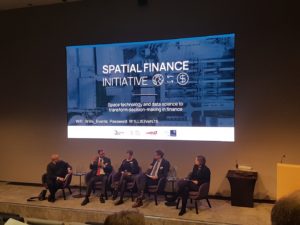Growing Sustainable Finance and the Opportunity for Geospatial Solutions
Marketing

Sustainable Finance is becoming increasingly relevant as our economic activities, fuelled by a global finance sector, keep reaching and breaching the natural and social boundaries of our planet. More and more institutional investors recognize environmental, social and governance factors as drivers of value, making sustainable investing the new normal. But, what is Sustainable Finance, why is it important, and what role can geospatial data play to grow its reach?
The transition to a sustainable global economy will be the most capital-intensive transition in human history. Infrastructure investments alone need to reach at least $6 trillion/year until 2030 to deliver on the Paris Climate Change Agreement according to an Inter-American Development Bank report. A new and resilient financial system is required to underpin this economic transition. Getting financial markets to integrate climate change, environmental, and social sustainability into decision-making will help financial institutions appropriately manage risk, reduce losses, and improve the resilience of the financial system.
Sustainable Finance
The term ‘Sustainable Finance’ as we define it, covers the range of activities, products, and stakeholders that aim to align the existing financial system with global sustainability. This includes the deployment of private finance towards more sustainable outcomes but does not cover the deployment of public and concessional sources of finance for sustainable development. Both sources of finance have different roles to play but are complementary and can enforce each other to become greater than the sum of its parts.
Leveraging the power of private finance can be achieved by reducing the cost or increasing the availability of capital for ‘sustainable’ alternatives whilst increasing the cost or decreasing the availability of capital for unsustainable alternatives. It includes: better risk management of environmental risks related to physical environmental change; societal responses to this change; and supports systemic changes and the adoption of sustainable practices.
Relevance of geospatial data
Satellite data has some inherent qualities that could complement current information sources within the finance sector. Satellite imagery offers a non-invasive and unbiased source of information compared to, for example, self-reported information from publicly listed companies. Data captured from the same instrument allows for standardised analysis and comparability of analysis across sites, assets and companies compared to the wide range of reporting methods, standards and quality across countries and companies. Depending on the satellite operator, imagery can be provided on a more frequent basis than the quarterly and annual reporting cycles known to the finance industry. Finally, ‘democratisation of space’ is making satellite imagery available and accessible to any interested party, including company management, investors or NGO’s where traditionally information was unevenly spread across the financial value chain.
We believe there are broadly two key opportunities, or value propositions, for satellite imagery and geospatial data within the Sustainable Finance sector. The first opportunity is around providing better, more robust and transparent information around financial assets’ risks, opportunities and impacts. This includes the performance on Environment Social and Governance (ESG) topics, analysis and compliance of supply chain risks, and physical climate change related risks and their potential financial impacts. The second opportunity is around reducing transaction and management costs of sustainable financial products and creating scalability for these products through more efficient monitoring, reporting and verification. Such products include SDG bonds, green loans or environmental and social impact funds.

What will Catapult do?
As part of Catapult’s role to explore and activate new markets for the UK space sector we will be looking at this area to identify the most relevant opportunities for geospatial data and solutions. To bridge the gaps in terms of awareness, skills and terminology we will be working with both the UK space sector and the Sustainable Finance sector to bring them closer together. Through market research, technology demonstrations and events we aim to demystify both sectors and raise awareness about the opportunities that exist for mutual growth.
We will be setting up collaborations and programmes of work to channel expertise and funding to UK businesses willing to commercialise products and services in this area. Our first multi–stakeholder collaboration, the Spatial Finance Initiative, was launched on the 1st February in the City of London to an audience of over 250 finance executives and practitioners. The event showed a strong interest for and acknowledgement of the huge potential for integrating geospatial data within decision making in finance. Alongside the Alan Turing Institute, City of London Green Finance Initiative and the University of Oxford Smith School of Enterprise and the Environment, we will be using the Initiative as a vehicle to undertake globally significant academic research and support UK businesses to translate this into operational and commercial finance-related applications.
Alignment of finance and sustainability is needed, and it is happening, but will it happen fast enough? Geospatial products and services can play a key role in accelerating this movement but not on its own. When satellite data is combined with other data sources and technologies and presented in a way that is both relevant and understandable to the finance industry, the potential for growth in both Sustainable Finance and the space sector is huge.




